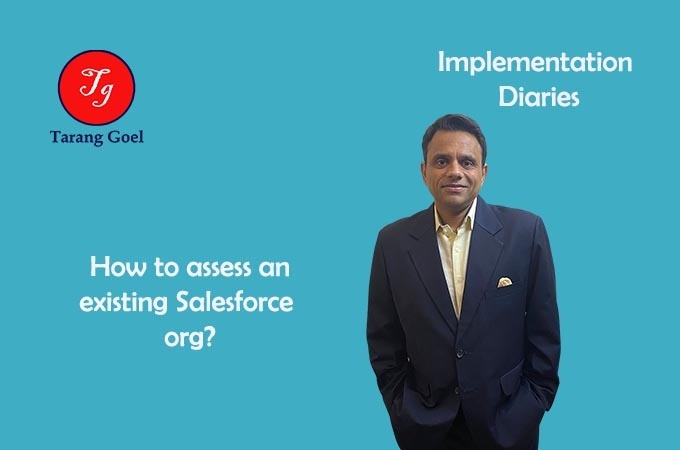We will talk about how an existing Salesforce org can be assessed.
Here are the needs for Org assessment:
- When a system integrator is taking over an org from an existing support team to perform production support and continuous application development
- In case of an implementation of a fresh org in the same company
- In case multiple existing orgs are getting consolidated into one (Instance consolidation project)
- if you are a consultant and have just joined a client or an existing implementation
How to assess a Salesforce quickly?
An org can be assessed on multiple parameters, here are some:
- Implemented business processes
- Size & Data density
- Degree of customization
- Code Migration Practice
- Integration Complexity
- Analytics
- User adoption
- Data and Org level security
Here is how you can use the above parameters and provide a quick org assessment:
Implemented Business processes – In order to know the implemented business process browse the Apps, Used standard and custom objects along with their record types. For example, if Lead to Cash is implemented in an org then the following objects could be in use- Accounts, Contacts, Leads, Opportunities, Opportunity Products, Products, Pricebook, Quote, Contracts and or orders. Custom objects related to them could also be used. You can go to the schema builder and look at all related objects to the above in use. It is advisable to explain this item first as with this you confirm the scope of the current implementation and establish your credibility with the client stakeholders
Size and Data Density- It’s important to understand the size of the implementation. Data density is defined as the amount of records present in the system. For example, the number of users using this application, number of accounts, contacts leads, opportunities etc. All this can be figured out by running SOQL queries either in the developer console or in the Salesforce workbench. Application with greater than 500 users and 50,000 accounts comes in the medium category and so on and so forth.
Degree of Customization- ‘System Overview’ under environments in Salesforce set up can provide the following technical information through which the degree of customization can be obtained for example- Number of custom objects, Custom meta data types, Org storage, API usage, APEX Triggers, Classes, Code usage, Roles, Visualforce pages custom meta data types etc. This information can provide a good technical overview about an org which can be used to derive conclusions and recommendations.
Code Migration Practice– It is important to know the current sandbox and release management environment in which the org is operating. Another question here is to find out if Dev-Ops is implemented and about the current branching strategy. Is it compliant with Git-GitHub?.
Is CI-CD used? (Continuous Integration- Continuous Development). If dev ops is not implemented then how is the code moving through the release process. Through change sets, ANT tool, Salesforce DX or Eclipse IDE or through some other tool. This information can be used to provide multiple recommendations. These questions be asked from the current Tech lead or the admin responsible for the Org or the application owner.
Integration complexity– It is vital to know the integration landscape of the current org. What are the process and data integrations implemented? What is the middleware used to integrate? For example, Dell Boomi, Mulesoft or TIBCO or any other tool. Consultant analyzing the org should be conversant with the Salesforce integration patterns and should able to quickly classify the existing integration into various Salesforce integration patterns. Any integration which is not following the Salesforce patterns should be called out. This can be talked about in details. I will do a separate blog on the same.
In addition to the above factors there is Analytics, User adoption and Data and Org Security assessment which need many more words then this blod can accommodate. I will make it a point to write specifically about them.
I hope you have enjoyed the above info. Your likes, share’s and comments will motivate me to keep writing.


0 Comments